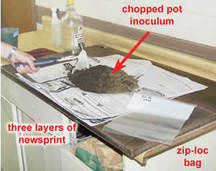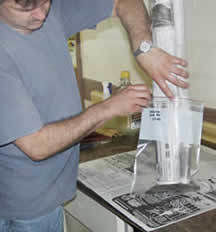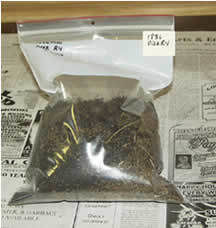Refrigerated Storage
Walk-in Cold Room at 4°C.
The fully dried contents of pot cultures are stored in a walk-in cold room at 4°C. The duration of storage varies with genus and sometimes species. Anecdotal evidence has alerted us to the following trends:
- Spores of Gigaspora species degrade most rapidly, and our practice is to store cultures of these species for less than one year before repropagation. Vigilance is especially important with these species, since the spores are the only infective propagules and when they all degrade, the culture is dead.
- Spores of other large-spored genera in Gigasporaceae (Cetraspora, Dentiscutata, Racocetra, Scutellospora) degrade less rapidly than those of Gigaspora, but there is considerable variation among species. Large, dark-spored species degrade much faster than species with smaller pale-colored spores. A much higher frequency of parasitism, especially by saprophytic fungi, is observed in spores of the former.
- Small, white or pale-colored spores of species in Acaulospora, Diversispora, and Paraglomus, in general, are the most resistant to degradation and parasitism. In contrast, glomoid species with large darkly pigmented spores tend to be more heavily parasitized and thus degrade faster over time.
- Longevity of species forming glomoid spores in refrigerated storage varies considerably amongst genera. In general, however, dark-spored species, large or small, tend to lose viability faster than small pale or colorless-spored species. But notable exceptions exist. For example, Rhizophagus clarus is a larger pale-spored species, and spores of most isolates degrade almost as rapidly as those of Gigaspora when propagated in a medium containing soil. Parasitism again is an important causal factor, and many glomoid spore-forming species (Claroideoglomus, Funneliformis, Rhizophagus, and Septoglomus) have a mucilagenous layer (staining pink to red in Melzer’s reagent indicating a high carbohydrate content) coating spore surfaces, and that layer often is heavily colonized by saprophytic bacteria and fungi.
Between 800 and 1000 liters of inocula are stored at 4°C at any given time. For individual cultures, the volume typically stored ranges from 500 cm cubed (deepots) to 1200 cm cubed (15 cm diam pots). This encompasses both stocks and trap cultures.
To store “whole” inocula from mixed or monospecific pot cultures, a thick cutting board is swabbed twice with 70% alcohol. Three layers of newsprint are placed on this surface, after which pot contents are chopped with a flame-sterilized hatchet.

The chopped material is wrapped in two layers of the newsprint, and one end is inserted into a pre-labelled zip-loc bag.

Once all of the chopped material is transferred to the bag, the newsprint is carefully removed and the bag is sealed. At no time is any of the material in the bag touched by human hands! Gloves, or thorough sterilization of hands with soap between pots, however, is required.

Bags then are arranged alphabetically by label in cold room or incubator. The inoculum in this example is a trap culture from a sugarcane field in Florida, so it was harvested with contents slightly moist to preserve integrity of spores (which will be extracted within 90 days to start monospecific cultures).
